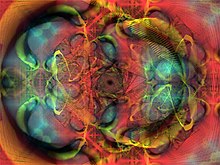Music visualization: Difference between revisions
Tag: repeated addition of external links by non-autoconfirmed user |
|||
| Line 39: | Line 39: | ||
==External links== |
==External links== |
||
*[http://creativelab.kiev.ua/eng/index_eng.htm creativelab.kiev.ua] Description of a way to transform music into a picture through numbers and geometrical proportions |
*[http://creativelab.kiev.ua/eng/index_eng.htm creativelab.kiev.ua] Description of a way to transform music into a picture through numbers and geometrical proportions |
||
*[http://www.fiprovision.com Brainwaves Rainbow Workshop] |
|||
{{Media player (application software)}} |
{{Media player (application software)}} |
||
Revision as of 10:20, 31 December 2009
This article needs additional citations for verification. (February 2009) |

Music visualization, a feature found in some media player software, generates animated imagery based on a piece of recorded music. The imagery is usually generated and rendered in real time and synchronized with the music as it is played.
Visualization techniques range from simple ones (e.g., a simulation of an oscilloscope display) to elaborate ones, which often include a plurality of composited effects. The changes in the music's loudness and frequency spectrum are among the properties used as input to the visualization.
History
Music and audio players were available on early home computers, Sound to Light Generator (1985, Infinite Software) used the ZX Spectrum's cassette player for example.[1] One of the first music visualization programs was the open-source, mult-platform Cthugha (1994). Subsequently, computer music visualisation became widespread in the mid to late 1990s as applications such as Winamp (1997), Audion (1999), and SoundJam (2000). By 1999, there were several dozen freeware non-trivial music visualizers in distribution.
In particular, MilkDrop by Ryan Geiss, G-Force by Andy O'Meara, and Advanced Visualization Studio (AVS) by Nullsoft became popular music visualizations. AVS is part of Winamp and has been recently open-sourced, and G-Force was licensed for use in iTunes[2] and Windows Media Center[citation needed] and is presently the flagship product for Andy O'Meara's software startup company, SoundSpectrum. More recently NoiseCradle has made it possible to incorporate videos and live webcam feeds into music visualizations. The real distinction between music visualization programs such as Geiss' MilkDrop and other forms of music visualization such as music videos or a laser lighting display is the visualization programs' ability to create different visualizations for each song every time the program is run.
List of music visualization software
- Advanced Visualization Studio (Justin Frankel)
- MilkDrop (2001, Ryan Geiss) and an OpenGL implementation, projectM
- Neon (Jeff Minter and Ivan Zorzin, 2004)
- Morphyre (Gordon Williams, 2009)
- NoiseCradle (NoiseCradle)
- TronMe (2006, 3D Solar)
- Virtual Light Machine (1990, Jeff Minter)
- Windows Media Player (Microsoft)
- Vsxu (2003, Vovoid)
- iTunes (2006, Apple)
- R4 (2003, Gordon Williams)
- G-Force (2000, Andy O'Meara, SoundSpectrum)
An early "light synthesizer", Psychedelia (1984, Jeff Minter), did not use audio input but was designed to create visualizations in accompaniment to music.
See also
Notes
- ^ "Sound to Light Generator". World of Spectrum. Retrieved 2009-02-20.
- ^ "About iTunes" - iTunes 8.0.0.35 credits
External links
- creativelab.kiev.ua Description of a way to transform music into a picture through numbers and geometrical proportions
- Brainwaves Rainbow Workshop
